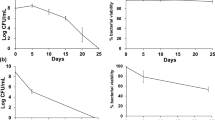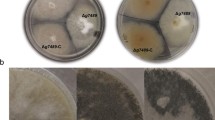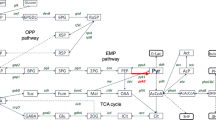Abstract
The presence of two alkaline/neutral invertases (Inv-A and Inv-B) in the filaments of Nostoc (also named Anabaena) sp. strain PCC 7120 and the involvement of sucrose metabolism in nitrogen fixation led us to investigate the physiological function of those isoforms in cells growing under different nitrogen sources. The highest expression level of each encoding gene was obtained in the presence of ammonium. These results were paralleled by polypeptide and enzyme activity level. In cells of N2-fixing filaments, localization of gene expression and subcellular enzyme activity assays demonstrated that invA gene (alr1521) expresses only in vegetative cells, whereas for invB (alr0819), expression is detected in both vegetative cells and heterocysts. In contrast to invA, when invB was knocked out, the filaments were unable to grow on diazotrophic conditions and the accumulation of sucrose and glycogen was altered. Our results demonstrate an essential role for Inv-B for diazotrophic growth and that Inv-B plays a key role in the coordination of sucrose and glycogen metabolism. We can also suggest that invB is likely to integrate the repertoire of genes regulated by a cyanobacterial transcription factor (NtcA) that plays a central role in global nitrogen control.







Similar content being viewed by others
Abbreviations
- A/N-Inv:
-
Alkaline/neutral invertase
- Chl:
-
Chlorophyll
- FW:
-
Fresh weight
- Inv:
-
Invertase
- gfp :
-
Green fluorescent protein encoding gene
- Suc:
-
Sucrose
- SPS:
-
Sucrose-phosphate synthase
- SuS:
-
Sucrose synthase
References
Cai Y, Wolk CP (1990) Use of a conditionally lethal gene in Anabaena sp. strain PCC 7120 to select for double recombinants and to entrap insertion sequences. J Bacteriol 172:3138–3145
Cumino A, Ekeroth C, Salerno GL (2001) Sucrose-phosphate phosphatase from Anabaena sp. strain PCC 7120: isolation of the protein and gene revealed significant structural differences from the higher-plant enzyme. Planta 214:250–256
Cumino A, Curatti L, Giarrocco L, Salerno GL (2002) Sucrose metabolism: Anabaena sucrose-phosphate synthase and sucrose-phosphate phosphatase define minimal functional domains shuffled during evolution. FEBS Lett 517:19–23
Cumino AC, Marcozzi C, Barreiro R, Salerno GL (2007) Carbon cycling in Anabaena sp. PCC 7120. Sucrose synthesis in the heterocysts and possible role in nitrogen fixation. Plant Physiol 143:1385–1397
Curatti L, Flores E, Salerno G (2002) Sucrose is involved in the diazotrophic metabolism of the heterocyst-forming cyanobacterium Anabaena sp. FEBS Lett 513:175–178
Curatti L, Giarrocco L, Salerno GL (2006) Sucrose synthase and RuBisCo expression is similarly regulated by the nitrogen source in the nitrogen-fixing cyanobacterium Anabaena sp. Planta 223:891–900
Curatti L, Giarrocco LE, Cumino AC, Salerno GL (2008) Sucrose synthase is involved in the conversion of sucrose to polysaccharides in filamentous nitrogen-fixing cyanobacteria. Planta 228:617–625
Elhai J, Wolk CP (1988) Conjugal transfer of DNA to cyanobacteria. Methods Enzymol 167:747–754
Ernst A, Böger P (1985) Glycogen accumulation and the induction of nitrogenase activity in the heterocyst-forming cyanobacterium Anabaena variabilis. J Gen Microbiol 131:3147–3153
Ernst A, Reich S, Böger P (1990) Modification of dinitrogenase reductase in the cyanobacterium Anabaena variabilis due to C starvation and ammonia. J Bacteriol 172:748–755
Falkowski PG (1997) Evolution of the nitrogen cycle and its influence on the biological sequestration of CO2 in the ocean. Nature 387:272–274
Fernández-Piñas F, Leganés F, Wolk CP (1994) A third genetic locus required for the formation of heterocysts in Anabaena sp. strain PCC 7120. J Bacteriol 176:5277–5283
Hagemann M, Erdmann N (1997) Environmental stresses. In: Rai AK (ed) Cyanobacterial nitrogen metabolism and environmental biotechnology. Springer/Narosa Publishing House, New Delhi, pp 155–221
Herrero A, Muro-Pastor AM, Flores E (2001) Nitrogen control in cyanobacteria. J Bacteriol 183:411–425
Herrero A, Muro-Pastor AM, Valladares A, Flores E (2004) Cellular differentiation and the NtcA transcription factor in filamentous cyanobacteria. FEMS Microbiol Rev 28:469–487
Jensen BB, Cox RP, Burris RH (1986) Isolation of cyanobacterial heterocysts with high and sustained dinitrogen-fixation capacity supported by endogenous reductants. Arch Microbiol 145:241–247
Keppler D, Decker K (1981) Glycogen. In: Bergmeyer HU (ed) Methods of enzymatic analysis, vol VI. Verlag Chimie, Weinheim, pp 11–18
Luque I, Forchhammer K (2008) Nitrogen assimilation and C/N balance sensing. In: Herrero A, Flores E (eds) The cyanobacteria. Molecular biology, genomics and evolution. Caister Academic Press, Norfolk, pp 335–382
Marcozzi C, Cumino AC, Salerno GL (2009) Role of NtcA, a cyanobacterial global nitrogen regulator, in the regulation of sucrose metabolism gene expression in Anabaena sp. PCC 7120. Arch Microbiol 191:255–263
Porchia AC, Curatti L, Salerno GL (1999) Sucrose metabolism in cyanobacteria: sucrose synthase from Anabaena sp. strain PCC 7119 is remarkably different from the plant enzymes with respect to substrate affinity and amino-terminal sequence. Planta 210:34–40
Puebla AF, Salerno GL, Pontis HG (1997) Fructan metabolism in two species of Bromus subjected to chilling and water stress. New Phytol 136:123–129
Reed RH, Richardson DL, Warr RLC, Stewart WDP (1984) Carbohydrate accumulation and osmotic stress in cyanobacteria. J Gen Microbiol 130:1–4
Roby C, Cortes S, Gromova M, Le Bail JL, Roberts JK (2002) Sucrose cycling in heterotrophic plant cell metabolism: first step towards an experimental model. Mol Biol Rep 29:145–149
Rohwer JM, Botha FC (2001) Analysis of sucrose accumulation in the sugar cane culm on the basis of in vitro kinetic data. Biochem J 358:437–445
Salerno GL, Curatti L (2003) Origin of sucrose metabolism in higher plants: when, how and why? Trends Plant Sci 8:63–69
Sambrook J, Russell DW (2001) Molecular cloning: a laboratory manual, 3rd edn. Cold Spring Harbor Laboratory Press, Cold Spring Harbor
Schilling N, Ehrnsperger K (1985) Cellular differentiation of sucrose metabolism in Anabaena variabilis. Z Naturforsch 40:776–779
Sugaya N, Sato M, Murakami H, Imaizumi A, Aburatani S, Horimoto K (2004) Causes for the large genome size in a cyanobacterium Anabaena sp. PCC7120. Genome Inform 15:229–238
Ting CS, Rocap G, King J, Chisholm SW (2002) Cyanobacterial photosynthesis in the oceans: the origins and significance of divergent light-harvesting strategies. Trends Microbiol 10:134–142
Vargas WA, Salerno GL (2010) The Cinderella story of sucrose hydrolysis: alkaline/neutral invertases, from cyanobacteria to unforeseen roles in plant cytosol and organelles. Plant Sci 178:1–8
Vargas W, Cumino A, Salerno GL (2003) Cyanobacterial alkaline/neutral invertases. Origin of sucrose hydrolysis in the plant cytosol? Planta 216:951–960
Vargas W, Pontis HG, Salerno GL (2007) Differential expression of alkaline and neutral invertases in response to environmental stresses: characterization of an alkaline isoform as a stress-response enzyme in wheat leaves. Planta 226:1535–1545
Vioque A (1992) Analysis of the gene encoding the RNA subunit of ribonuclease P from cyanobacteria. Nucleic Acids Res 20:6331–6337
Walton DK, Gendel SM, Atherly AG (1992) Nucleotide sequence of the replication region of the Nostoc PCC 7524 plasmid pDU1. Nucleic Acids Res 20:4660
Winter H, Huber SC (2000) Regulation of sucrose metabolism in higher plants: localization and regulation of activity of key enzymes. Crit Rev Plant Sci 19:31–67
Wolk CP, Ernst A, Elhai J (1994) Heterocyst metabolism and development. In: Bryant DA (ed) The molecular biology of cyanobacteria. Kluwer, Dordrecht, pp 769–823
Xu X, Ehai J, Wolk CP (2008) Transcriptional and developmental responses by Anabaena to deprivation of fixed nitrogen. In: Herrero A, Flores E (eds) The cyanobacteria. Molecular biology, genomics and evolution. Caister Academic Press, Norfolk, pp 383–422
Zhu J, Jäeger K, Black T, Zarka K, Koksharova O, Wolk CP (2001) HcwA, an autolysin, is required for heterocyst maturation in Anabaena sp. strain PCC 7120. J Bacteriol 183:6841–6851
Acknowledgments
We are very thankful to L. Curatti, A. Cumino, and H.G. Pontis for helpful discussions, E. Etxeberria and P. Weyman for insightful reading of the manuscript, and C. Fernández for technical assistance. This research was funded by grants from CONICET, Universidad Nacional de Mar del Plata, ANPCyT (PICT No. 21227) and FIBA.
Author information
Authors and Affiliations
Corresponding author
Electronic supplementary material
Below is the link to the electronic supplementary material.
Supplemental Fig. 1
Generation of invA- and invB- mutant strains derivative from Nostoc sp. PCC 7120. a and b Genomic map depicting the construction of invA- and invB- insertion mutant strains, respectively. Cassettes coding for Em and Nm resistance were used to interrupt the coding region of invA or invB, respectively.c and d Electrophoresis of PCR-amplified DNA fragments confirming invA and invB interruption. Clones displaying resistance to Em or Nm were analyzed by PCR using the primer pair 366UEB/366LES or 182LES/182UEB, respectively. The former primer pair amplifies a 1,424-bp DNA fragment in the wild-type strain and a 3,424-bp DNA fragment in the invA- knockout strain. The latter primer pair amplifies a 1,469-bp DNA fragment in the wild-type strain and a fragment of 2,669 bp in the invB- knockout strain. e Schematic depicting of the construction of the invB+ mutant strain. It was generated cloning the coding region of invB in the plasmid pRL1404. The coding region of invB is transcribed from a promoter within the Nostoc replicon pDU1 (Walton et al., 1992). f Polypeptide levels determined in Nostoc sp. PCC 7120 (7120) and derivative mutant strains invA-, invB- and invB+. The three strains were grown in the presence of KNO3 as the source of combined nitrogen until the cultures reached an OD600 = 0.5. The samples were split for total protein extract preparations. A/N-Inv polypeptides were immunodetected by Western immunoblot analysis with anti-His6::Inv-B (Vargas et al. 2003). (TIFF 1432 kb)
Supplemental Fig. 2
Suc content (a and b) and Inv activity (c and d) in Nostoc sp. PCC 7120 (7120) and in derivative mutants (invA−, invB- and invB+). (TIFF 1138 kb)
Supplemental Fig. 3
Growth of Nostoc sp. PCC 7120 (7120) and derivative invA- mutant strain in different nitrogen sources. Cells were cultured in the presence of dinitrogen (a), NH4Cl (b) or KNO3 (c). Samples from each culture were collected every two days and optical density was determined. The plots represent the natural logarithm (ln) of the increase in optical densities vs days (based on the equation: ln (OD-OD0) = μ.t + ln e). Similar plots were obtained when growth curves were based on fresh weight or chlorophyll content. (TIFF 1163 kb)
Supplemental Fig. 4
Morphology of the filaments of the Nostoc sp. PCC 7120 (7120), invA-, invB- and invB+ strains grown in diazotrophic conditions or in the presence of NH4Cl for 10 days. Bright field images were photographed and processed with same settings and were taken at the same magnification (1,000x), to allow qualitative comparison of the filaments. Arrowheads indicate heterocysts. (TIFF 2671 kb)
Supplemental Fig. 5
Position of genes related to Suc metabolism in the genome of Nostoc sp. PCC 7120. Genes encoding proteins involved in Suc synthesis (spsA and spsB) and degradation (susA, invA, and invB). The imaginary line dividing the genome (265º - 85º) in two halves suggested by Sugaya et al. (2004) is indicated with a green dotted line. (TIFF 7502 kb)
Rights and permissions
About this article
Cite this article
Vargas, W.A., Nishi, C.N., Giarrocco, L.E. et al. Differential roles of alkaline/neutral invertases in Nostoc sp. PCC 7120: Inv-B isoform is essential for diazotrophic growth. Planta 233, 153–162 (2011). https://doi.org/10.1007/s00425-010-1288-5
Received:
Accepted:
Published:
Issue Date:
DOI: https://doi.org/10.1007/s00425-010-1288-5




